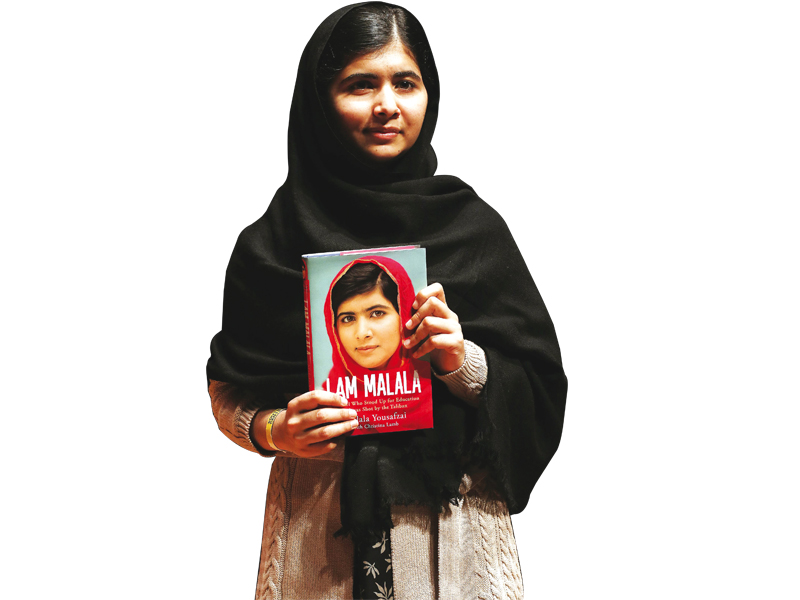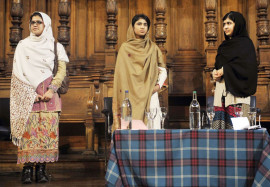
Young, bright-eyed, Malala Yousafzai leaves the likes of Jon Stewart speechless, candidly tells Christiane Amanpour she would visit the Buckingham Palace as it is the order of the Queen, and has been named as one of TIME magazine’s 100 most influential people in the world. But her story is a far cry from the splendour she now sees.
In her autobiography, I Am Malala, co-authored by Christine Lamb, a British journalist, the 16-year-old takes us through the everyday life of a young girl in the Taliban infused city of Swat. The memoir traces her life and the incidents in her hometown that forced her to speak out publicly for the right of education for girls, long before she was shot and thrust into international limelight.
The book begins with an intriguing description of the Pashtun culture and Swat, a place she often refers to as the Switzerland of Pakistan. A brief history of the Pakistani political landscape dating back to Gen Zia’s regime, told mostly through her father’s recollection, gives a broader perspective on the geo-political dynamics that have shaped the country in its present form. We learn significantly about her father, Ziauddin Yousafzai, who once struggled for his own education. As a teacher and an activist, he persistently campaigned for the rights of the people of Swat. Unlike most men in his tribe, who mourned the birth of daughters, he took great pride in Malala and named her after a renowned female Pashtun warrior.
And Malala was every bit of the warrior that her father envisioned her to be. Using accounts from her personal life, the book allows you to see for yourself that Malala is no ordinary girl. Her spirit is almost tangible when you see her questioning everyday injustices, that even many adults have made peace with. For example, she shares the story of a 10-year-old girl married to an old man, an incident that troubled her deeply. “I am very proud to be Pashtun, but sometimes our code of conduct has a lot to answer for, especially in its treatment of women,” she says. She continues to debate the legitimacy of the Taliban mindset, especially when it came to stopping girls from going to school. And with her father’s support, she ensures that these questions make way to the right ears.
Malala’s mother, an illiterate but progressive woman, would share her concern for her daughter’s safety but would not prevent her from speaking up. In fact a poignant detail in the book is the moment her mother learns of the ruthless attack on her daughter, was the day she was to start learning how to read and write.
The book does not offer a thorough critique of the West’s military operations in the region, and it can be debated that a significant portion is a reflection of her father and Lamb’s analysis of Pakistani history and politics, rather than that of the 16-year-old herself.
However, it allows you to taste the fear of living in a regime where books are shunned and the wrong length of your beard can get you killed. It enables you to understand how bewildering the current situation in the country can be for a young child who just wants a normal life.
Published in The Express Tribune, Sunday Magazine, November 17th, 2013.
COMMENTS (13)
Comments are moderated and generally will be posted if they are on-topic and not abusive.
For more information, please see our Comments FAQ


































































@Ahmad- The drones kill innocent victims. The Taliban kill innocent victims. Nabila is an innocent victim: We live in a world where innocent victims are promptly forgotten. That is profoundly sad and unfortunate. Pakistan has been petrified into paralysis by what is essentially a nihilistic, blood thirsty, death worshipping cowardly cult. Political leaders dare not condemn them by name. In the recent All Parties Conference declaration they are referred to as stakeholders and 'our' people. And from this cowering, dithering, prevaricating nation emerged a girl child called Malala, who confronted these sub-human creatures with resolute determination, indomitable spirit and unimaginable courage. Even when they shot her and left her dead, she rose again like Phoenix. And she emerged, not with her spirit broken or deeply traumatised and shattered, and haunted by nightmares, but with even more commitment, determination and vigour and with the same poise, grace and eloquence. Even forgiveness for that beast who shot her. What sets Malala apart is her refusal to become a victim. Comprende?
@Zara: If you want to discuss something different, why are you here? Go find a site of your choice. Its that simple..
@Khan Sahib: Taliban don't spare anybody- not even apologists like you.A girl is fighting against what cowards like you should be.Shameful!
@Ahmad-: Very well said, just to add few words, if you are backed by west and you are serving their interests you are MALALA otherwise NABILA
Very well said Mr. Ahmad. Just to add few words, if you are backed by west and you are serving their interests then you are MALALa otherwise NABILA.
Malala and Nabila, Malala couldnt go to school because taliban blew up her school. she wanted to continue education and were shot by Taliban. She survived and running a campaign for education of girls in pakistan having 1.2 billion dollars Charity fund !! she becomes a hero making headlines all over the world winning awards
Nabila is from KPK, she had her family relatives killed in Drone Attack while working in a farm, she was wounded herself probably lost her leg, she was invited by an american senator to speak at US senate, her translated started weeping translating her story, She said we can not go to school because of drones, shes scared of open sky she likes clouds on sky so thres no Drone !! she makes no headlines shes not a hero !! so u get famous only if u get shot by Taliban and ur not even counted if killed by drones
Enough of this Malala's book. Don't we have anything else to discuss
Might is right is an old saying of the wise. Hitier was of the oinion that every illegal action can be legalised throgh force though he could not succeed to prove it but the ideology is still applied in Pakistan to replace the democratic system with theocracy despotic rule. I am Malala is not only a personal account of a teen girl but the story of four million peple who displaced from the paradise valley of Swat and adjacent distrcts in hot summer to wandered in distitute. They had numerous stories of babarisom in thier minds the scene of butchering their brother and relatives but they were so demoralised to diclose them. among the millions of people only two dared to reveal what they had seen. Malala and her father. the voice was so powerful and impressive that Malala was considered a serious threat to the forces of violence. the result was that what hapned to her.
Should be translated to make sure every young student gets to read it. Just a story of a girl wanting to be equal, free and modern without sacrificing her cultural roots or religion.
And it is a story of bravery of her father, as much as her, in standing up to the tyranny of medieval culture being imposed on a modern population. No religion is meant to be a stale water, which will breed disease. Time to time it will need to be interpreted in the new light thus fresh water cleanses the lives.
Having read the book I must say that was a very balanced and accurate summary of the book.